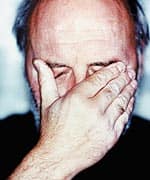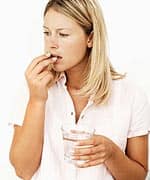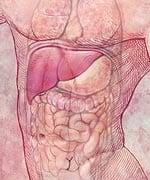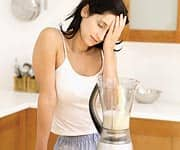Life Extension Magazine®
For the first time, there is a safe, proven cure for migraine headache and its associated symptoms. I developed this treatment protocol out of a long-term clinical study in which all the patients—100%—achieved complete relief from migraine pain and related symptoms, including individuals who had difficult-to-treat migraine that had plagued them for more than 30 years. Since that study, I have repeatedly achieved the same results with hundreds of men, women, and adolescents in the United States and around the world, regardless of whether they had been suffering episodes of migraine pain for a few months or for decades. Excerpted from The Migraine Cure by Sergey A. Dzugan, MD, PhD (Dragon Door Publications, Inc., 2006). What you need to know
Problems with Migraine DrugsMillions of women and men who suffer with migraine are looking for relief. Migraineurs (people who suffer from migraine) generally are very dissatisfied with current treatment options, not only because they are not effective, but also because they are often accompanied by adverse effects. It is generally accepted, for example, that about 35% of patients who take sumatriptan—the most commonly prescribed medication for migraine—and similar migraine medications will experience another migraine attack within 24 hours of treatment.
When it comes to side effects, in one study, researchers found that 44.5% of the patients reported adverse events—including dizziness, headache, nausea, difficulty in thinking, fatigue, and tingling of the toes and fingers—after using various medications. Some patients are so discouraged by the side effects that they elect to forgo treatment rather than suffer additional pain and discomfort. Indeed, the use of beta blockers, calcium channel blockers, ergots, and even some over-the-counter non-narcotic painkillers can trigger migraines if they are used consistently. An Effective Migraine Treatment PlanThe "Migraine Cure" is based on balancing the function of specific systems in the body, and tailoring the dosing of specific hormones and other natural substances to meet the unique needs of each individual. If you want to eliminate your migraine, you and a competent health care professional need to identify your current levels of various hormones and nutrients, including calcium-to-magnesium ratio; establish the functioning status of your pineal gland and digestive/intestinal tract; and then choose which natural, biocompatible supplements you will need to restore all of your levels and functions to their natural, healthy state. All this is done without the use of drugs or expensive therapies. Steps to a CureIf I had to use one word to describe my approach to the successful treatment and elimination of migraine, that word would be "balance." The approach involves an orchestrated and synchronized adjustment of the components and functions of several systems in the body to achieve that goal. Those areas are as follows:
I. At Home with Your HormonesThe linchpin of The Migraine Cure can be presented in one simple statement: If you do not restore your key hormones to healthy, balanced levels, you will never cure your migraine. Before you can begin to balance your hormones, you will need to undergo a blood test to identify the levels of your basic steroid hormones. Once you have that information, you and your physician will have a reference point from which to begin restoration therapy. A lipid (blood fats) panel is also done at this time, to determine cholesterol levels. For women who are still menstruating, who comprise the majority of migraineurs, the optimal time to take the test is during days 19-21 of the menstrual cycle, as this is the time progesterone levels peak. While optimal hormone levels are critical, so is hormone balance. Thus, The Migraine Cure strives to restore a balanced ratio between complementary hormones, such as estrogen and progesterone, and cortisol and DHEA, rather than restoring individual hormones to absolute numbers. When we restore—not replace—selected hormones and achieve a hormonal balance that is specific to your unique body chemistry and needs, then we can eliminate migraine. Cholesterol: The First IngredientThe production of hormones begins with cholesterol. Therefore, having a healthy level of cholesterol is critical for adequate hormone production. Cholesterol levels that are too high or too low are unhealthy, including when it comes to balancing hormone levels. That is why when an individual with migraine wants to begin treatment, we always ask that he or she get a lipid panel (total cholesterol, LDL, HDL, and triglycerides) along with the hormone panel. PregnenolonePregnenolone is not only the most prevalent hormone in the brain, but is also considered to be a "grandmother" hormone, one from which all the human steroid hormones—including aldosterone, cortisol, cortisone, DHEA, estrogen, progesterone, and testosterone—are produced. (The term "steroid hormone" refers to a family of structurally similar biochemicals that have the ability to determine sex, reduce inflammation, and regulate growth.) Thus it follows that when levels of any of these hormones fall below normal, pregnenolone levels typically also are not normal, and vice versa. Here are some of the properties attributed to pregnenolone and some reasons why it is such an important hormone in the fight against migraine:
Pregnenolone supplements are manufactured from wild yams (Dioscorea villosa) and are bioidentical to the hormone that your body produces naturally. Generally, the dosage is 50-200 mg daily, taken in the morning on an empty stomach, with the goal of attaining an optimal serum level (typical of a person aged 20-29) of around 180 ng/dL for men or 200 ng/dL for women. Pregnenolone is considered safe even at high doses. However, because pregnenolone is converted into DHEA and progesterone, which are then converted into other hormones, periodic blood testing of hormones is recommended, as we do in The Migraine Cure. |
||||
DHEAWhile pregnenolone is the grandmother of hormones—and the precursor of dehydroepiandrosterone (DHEA)—DHEA is the mother, because it is a precursor for the estrogens and testosterone. While low levels of DHEA are associated with aging, they also have been linked with various health problems, including but not limited to migraine, chronic inflammation, depression, rheumatoid arthritis, memory and concentration difficulties, osteoporosis, heart disease (in men), increased risk for some cancers, and complications of type II diabetes. On the positive side, taking DHEA supplements to restore the hormone to youthful levels can help treat many of these same conditions.
One of the main functions of DHEA is to counteract the stress-damaging actions of cortisol. Maintaining an optimal DHEA-to-cortisol ratio is not only a critical key to anti-aging, but also important for achieving hormone balance and eliminating migraine. Your body's production of DHEA can be reliably identified by measuring the amount of DHEA-sulfate (DHEA-S) in a blood sample. The goal of DHEA supplementation is to restore levels to their youthful (age 20-29) range. For men, the optimal range is 500-640 ug/dL; for women, 250-380 ug/dL. The usual daily dose is 50-100 mg taken as an oral supplement. Because DHEA is a precursor for the estrogens and testosterone, it can have some effect on increasing the levels of these hormones. That is why it is important for women to undergo periodic blood tests to have the levels of these hormones checked. Quite often, we also recommend that individuals take 7-keto DHEA in addition to a regular DHEA supplement; 7-keto DHEA is a metabolite of DHEA (a product of DHEA metabolism). Perhaps the most important feature of 7-keto is that, unlike DHEA, it does not convert to estrogen and testos-terone. Therefore, availability of the supplement 7-keto DHEA allows you to take a lower dose of DHEA, which helps balance estrogen and testosterone levels and keeps cortisol levels in check. Estrogen and ProgesteroneEstrogen and progesterone are produced naturally by the body and typically thought of as female sex hormones. Indeed, females typically have higher levels of these two hormones than do males, but both estrogen and progesterone are found in people of both sexes and of all ages. The roles of estrogen and progesterone in migraine are both critical and complex. I have grouped these two hormones together because they are so intimately connected, and because we have found that it is the balance between them, and not the restoration of optimal levels individually, that is critical for elimination of migraine, as well as of the many symptoms women experience during perimenopause and menopause. A Power Trio: The Estrogens"Estrogen" is actually a blanket term for several types of the hormone, of which three—estriol, estradiol, and estrone—are the most important.
When the three estrogens are present and in proper balance with each other and with other steroid hormones, health and well-being are maintained. All three estrogens work together to support the central nervous system, determine female physical characteristics, minimize loss of calcium from bone, enhance skin health, promote blood clotting, and support ovulation, among other functions. Although all three play critical roles in the body, they are not equal in terms of safety or benefits. Estradiol and estrone, for example, along with their positive features, have cancer-causing abilities, and the body naturally allows for this negative characteristic by producing lower levels of these estrogens compared to the so-called "good" estrogen, estriol. In fact, estriol is believed to have cancer-reducing properties. Thus, the normal, healthy breakdown of total estrogens in women is 60-80% estriol, and 10-20% each of estradiol and estrone. Estrogen and MigraineThe relationship between estrogen levels and the development and elimination of migraine is an intimate one. Here is what we know about estrogen and migraine:
The form of bioidentical estrogen that I recommend is Triest gel, which I recommend be taken in a formulation that consists of 90% estriol, 7% estradiol, and 3% estrone. A compounding pharmacy can prepare this specific formulation for you. This formulation is most advantageous for women, especially those older than 35, because it provides a large percentage of safe estrogen (estriol), along with the other two types of estrogen. This gel should be applied in the morning after bathing, to areas such as the neck, forearm, or sides of the chest or abdomen. Progesterone: The "Other" Female HormoneThe balance between estrogen and progesterone is critical in the elimination of migraine, so let us look a little closer at how this important hormone works. Progesterone levels in the body naturally rise and fall during a woman's monthly cycle. Women can begin to miss ovulations as early as their mid-thirties, and missed ovulations become more common as perimenopause approaches. The combination of missed ovulations and the approach of menopause usually results in progressively lower levels of progesterone, which contribute to an imbalance with estrogen, whose levels are also always changing. This imbalance explains why many women begin to experience symptoms of perimenopause in their mid- to late thirties and forties, and also why the peak incidence of migraine for women is between the ages of 35 and 45. When we talk about progesterone therapy or supplementation, there are two types available: bioidentical progesterone, which is chemically the same as the progesterone produced by the human body, and thus behaves like the body's natural progesterone; and synthetic progesterone-like substances called progestogens or progestins. One of the first people to discover the benefits of natural progesterone was Dr. John Lee. When he recommended natural progesterone cream to his patients for symptoms of menopause, they reported relief from hot flashes, insomnia, bladder problems, dry eyes, irritability, hair loss, sore breasts, night sweats, and bloating, among other symptoms. The formulation of natural progesterone I recommend and use in The Migraine Cure is micronized progesterone USP. Micronized progesterone is also available as a gel (transdermal form), which is the form I recommend for migraine as well as for other conditions that benefit from hormone balancing. The micronized gel I recommend is available through compounding pharmacies, delivers 50 mg/mL, and should be applied in doses that simulate a woman's monthly cycle. An alternative is an over-the-counter micronized cream product called ProFem. TestosteroneTestosterone is typically characterized as the male hormone, the one responsible for the normal development of male sex and reproductive organs, and the development of secondary male sex traits, including hair growth (and loss) patterns, thickening of the vocal chord, muscle development, and other characteristics. Normal testosterone levels are necessary to maintain healthy mood, energy level, bone marrow production, fertility, and sexual desire. Females also need testosterone; their levels need not be as high as those of males, but their optimal levels should be sufficient to maintain good health. Testosterone levels need to be in balance to eliminate migraine in men and women as well. Measurement of testosterone levels is part of the male and female hormone panels that are used to identify the levels of other steroid hormones. The optimal range for men is 650-827 ng/dL; for women, 60-76 ng/dL.
Testosterone supplements are available in oral form (capsules, pills), by injection, through a transdermal patch, and in a gel. I recommend the latter form because it allows for individualized dosing and is easy to use. Although it is necessary to balance testosterone levels with the other steroid hormones as part of The Migraine Cure, that balance is frequently achievable without an individual having to use a testosterone supplement (mostly in younger people). In women, correct levels of DHEA can convert into testosterone whenever the body recognizes that levels are low. Thus, careful use of DHEA (a precursor of testosterone) restoration can help some women reach their optimal levels, while others need a testosterone supplement, at least temporarily. Treatment Enhancements: Zinc and PalmettoIn males, saw palmetto (Serenoa repens), an herb that grows naturally in the southeastern United States, is often used to help prevent prostate enlargement. That is because this herb blocks the conversion of testosterone to dihydrotestosterone (DHT), a substance that, among other things, stimulates growth of the prostate gland and causes hair loss. Specifically, saw palmetto inhibits the activity of 5-alpha-reductase, the enzyme that converts testosterone to DHT. Zinc can block aromatase enzyme, the factor that converts testosterone into estrogen. The addition of zinc could help facilitate an estrogen-progesterone balance. Most individuals who participate in The Migraine Cure need to take saw palmetto and/or zinc. When a female has symptoms that are associated with testosterone dominance, supplementing with this herb and nutrient can be beneficial. The typical dose of saw palmetto is 160 mg once daily, while the dose of zinc can range from 15 to 90 mg. | |||
II. Resetting the Pineal GlandIt may only be the size of a pea, but the pineal gland, located deep in the brain, plays a major role in both the development and elimination of migraine. That is because this tiny gland is the body's primary source of melatonin, a hormone that orchestrates the body's circadian (daily) rhythm, including and especially sleep patterns. MelatoninResearch findings support the idea that pineal gland irregularity, and thus melatonin imbalance, is involved in the development of migraine. Melatonin is an important piece in the migraine and sleep disturbance puzzle. Restoration of balanced pineal gland function and healthy sleep patterns are critical components in The Migraine Cure treatment program. Melatonin supplements are widely available, in grocery stores, pharmacies, health food stores, department stores, and by mail order. As part of the pineal restoration segment of The Migraine Cure, I recommend a combination product that contains melatonin (3 mg), vitamin B6, and kava kava, with one or two capsules taken at bedtime, depending on individual needs. In most cases, patients need to take melatonin for only a few months, until the pineal circadian cycle is restored. Then they may take it periodically for a few days per month or every few months if their sleep becomes disturbed. Kava KavaIn addition to melatonin, we recommend kava kava as part of the restoration program for pineal function. Kava root extract, which is derived from the root of Piper methysticum, has a calming effect, promotes sleep, and relaxes deep muscles, abilities attributed to components called kavalactones. Patients who follow The Migraine Cure plan as recommended typically take melatonin and kava at the beginning of the program, but once they are migraine-free—which usually happens within two to four weeks—they can reduce their use of melatonin and kava to a minimal dose and discontinue them later, depending on how well their sleep problems have resolved. The most common side effect from kava use is mild gastrointestinal disturbances in some people. Kava has also been associated with skin rashes and enlargement of the pupils. Kava should not be combined with drugs or substances that act on the central nervous system, such as alcohol or benzodiazepines. Individuals with liver problems should not use kava. Use of kava should generally be limited to three months. Vitamin B6Vitamin B6 (pyridoxine) is an important part of the migraine treatment program for several reasons. When it comes to restoring pineal function, vitamin B6 is necessary for the production of serotonin, the brain neurotransmitter that has a major role in the sleep-wake cycle, chronic pain, mood, and appetite. I also recommend it because, like kava kava, it has a calming effect. The typical dose is 10-20 mg taken 30 minutes before bedtime. III. Achieving Metabolic BalanceThe link between migraine and gastrointestinal (GI) disorders, and especially between GI disorders and the gut (intestinal tract), has been confirmed by numerous studies and clinical observations.
Successful elimination of migraine depends on a healthy gut, and fortunately, you have a great deal of control over that environment. One of the most important things you can do to ensure a healthy intestinal tract is to maintain a balance between friendly and unfriendly bacteria—the intestinal flora—in the gut. Friendly bacteria are those that provide health-promoting or health-maintaining properties, while the unfriendly varieties can significantly harm your health. When the balance tips in favor of the bad bacteria, the gut becomes damaged and inflamed. This condition, often called dysbiosis, is characterized by symptoms such as diarrhea, constipation, gas, abdominal pain, cramping, and bloating. As a person with migraine, when your gut feels like it is in knots—when you have symptoms of diarrhea, constipation, irritable bowel, or abdominal pain—you need to restore balance to your intestinal flora if you want to rid yourself not only of your gut pain but of your migraine as well. I have found an excellent way to accomplish this goal is through supplementation with probiotics. ProbioticsProbiotics are supplements of live, friendly bacteria that you can take to enhance or restore the balance of bacterial flora in your intestinal tract. The most common and essential of the friendly bacteria are the bifidobacteria, streptococcus, and lactobacilli species, which perform many functions essential for health and well-being. For example, they can:
After much research and experimentation, the probiotic supplement I recommend is a powdered formula that contains 3.5 billion of lactobacillus group, 1 billion of bifidobacterium group, and 0.5 billion of streptococcus thermophilus per dose. It is well tolerated, easy to use, and has helped a great many people. After several months of taking this supplement on a daily basis, most people find that occasional use, perhaps once a month, is sufficient to maintain a healthy gut and overall health and well-being. IV. Ion Balancing ActCritical for the success of The Migraine Cure is restoration of the balance between two minerals, ionized magnesium and ionized calcium. The precarious balance between these two elements is intimately connected with the activity of the steroid hormones, the function of the pineal gland, proper functioning of the digestive system, and, by extension, balance between the sympathetic and parasympathetic nervous systems. The Calcium-to-Magnesium RatioThe relationship between the calcium-to-magnesium ratio and migraine has been known for some time. In 1993, for example, researchers noted that low levels of ionized magnesium and a high ionized-calcium-to-ionized magnesium ratio are both associated with migraine, as these two conditions cause cerebral vasospasm and reduced blood flow to the brain. A balanced ratio of calcium to magnesium also is necessary to help prevent fatigue and regulate the sleep cycle, two factors common among migraineurs. Again, this balance also reflects a balance between the sympathetic nervous system (which calcium has an impact on) and the parasympathetic nervous system (which magnesium influences). MagnesiumIf a magnesium deficiency is part of the recipe for migraine, then it follows that supplementation should be beneficial. Research and experience indicate that this is true. Several studies have shown that supplementation with magnesium relieves migraine in people who have low serum ionized magnesium levels. We also know that supplementation with magnesium relieves symptoms of PMS, including migraine, bloating, and edema, and that magnesium supplementation can be an effective prophylactic (preventive agent) and treatment for migraine. Although magnesium supplements are available in a variety of types and forms (e.g., magnesium sulfate, oxide, gluconate, carbonate, and chloride), the form I recommend to everyone who participates in The Migraine Cure is magnesium citrate. This is the type the body is best able to absorb. I especially recommend a powdered, water-soluble magnesium supplement, 400-800 mg taken at bedtime, or 200-400 mg taken in the morning followed by 400 mg at bedtime, depending on individual needs. If you have any type of heart or kidney disease, talk to your doctor before taking magnesium. Additional Benefits of The Migraine CureOne of the most gratifying experiences in writing The Migraine Cure book, besides the fact that it eliminates migraine, is that it will also help people alleviate many other symptoms and conditions. This is good news, because most people who live with migraine also struggle with one or more other health problems, including depression, insomnia, high cholesterol, constipation, irritable bowel syndrome, chronic fatigue, fibromyalgia, mood swings, menstrual difficulties, or sleep disturbances. So while we were busy recommending hormone restoration, pineal resetting, calcium-magnesium rebalancing, and digestive realignment, and getting excellent results when it came to eliminating migraine, patients were reporting—and we were noting—that other health concerns were disappearing as well. My research and experience have shown me that the basics of The Migraine Cure are the recipe for successful treatment and often complete elimination of many other physical and psychological conditions, including high cholesterol, heart disease, and fibromyalgia.
|








